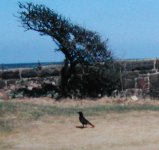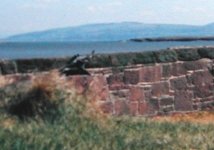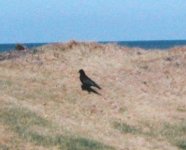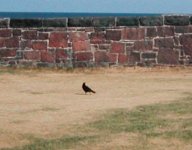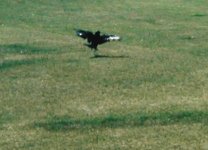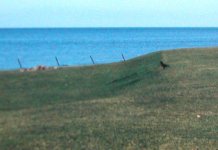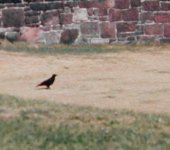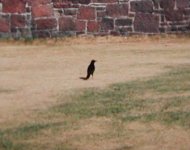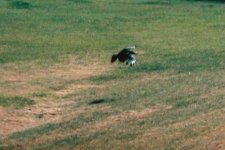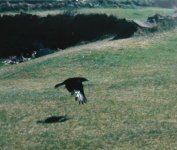Jane Turner
Well-known member
This bird has had me foxed for about 15 years. Lets see if anyone out there can help.
One hot late May morning, I was birding with a few friends at Red Rocks when I picked up a Corvid about a mile away coming in from Wales. Without a seconds hesitation I excitedly shouted Chough...since that is just what it looked like. Small, barely bigger than a Jackdaw, with long wings and huge fingers...and a longish narrow tail...and flying just like a Chough. As it came closer things started to go wrong... it had white wing flashes and where was its bill? It landed on the lawn of the point garden and was clearly not a chough.
There were odd patches of grey showing on the bird and I started to worry what Daurian Jackdaw might look like, having heard the name but never seen a description. It was hellishy shy and hard to photograph, but I got a few. At rest the bird was black though the understory of feathers was whitish grey. It had white bases (about 1/3) to inner and outer webs of its secondaries and primaries. The bill was quite stout and had a dull grey "wrinkly" oval on the base of the upper mandible.
I looked for possible escape species, but never got close. The most likely explaination I ever came up with was partial albino Jackdaw x Rook, but I'd love to hear other theories!
One hot late May morning, I was birding with a few friends at Red Rocks when I picked up a Corvid about a mile away coming in from Wales. Without a seconds hesitation I excitedly shouted Chough...since that is just what it looked like. Small, barely bigger than a Jackdaw, with long wings and huge fingers...and a longish narrow tail...and flying just like a Chough. As it came closer things started to go wrong... it had white wing flashes and where was its bill? It landed on the lawn of the point garden and was clearly not a chough.
There were odd patches of grey showing on the bird and I started to worry what Daurian Jackdaw might look like, having heard the name but never seen a description. It was hellishy shy and hard to photograph, but I got a few. At rest the bird was black though the understory of feathers was whitish grey. It had white bases (about 1/3) to inner and outer webs of its secondaries and primaries. The bill was quite stout and had a dull grey "wrinkly" oval on the base of the upper mandible.
I looked for possible escape species, but never got close. The most likely explaination I ever came up with was partial albino Jackdaw x Rook, but I'd love to hear other theories!
Attachments
Last edited:




